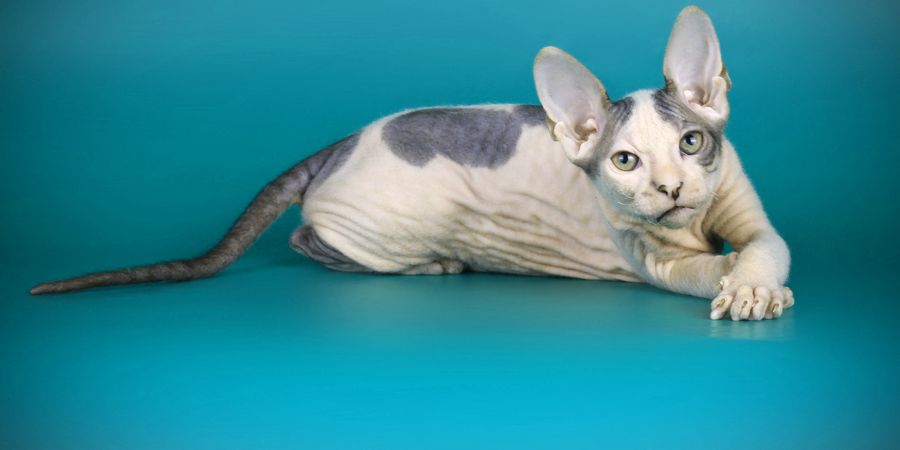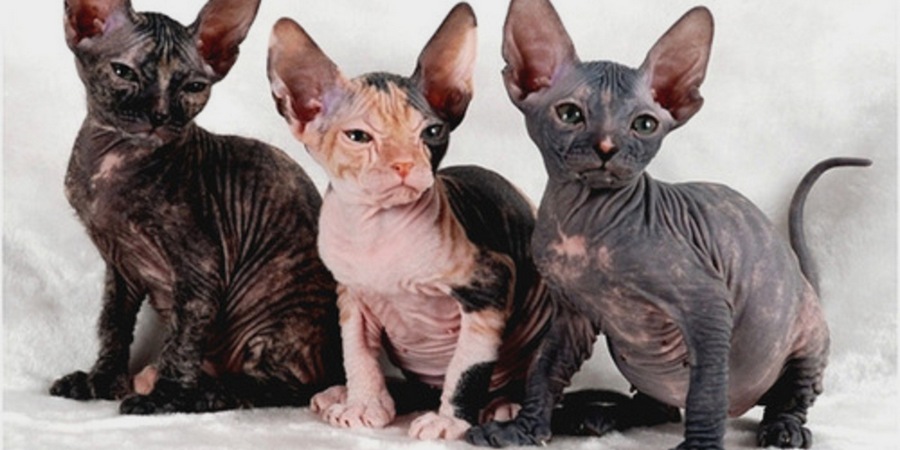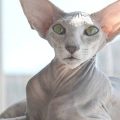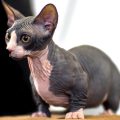Don Sphynx is a fairly new breed of hairless cat, whose appearance was the result of a spontaneous mutation and not a purposeful crossing of already existing bald breeds.
Good-natured, slightly lazy, and very intelligent Russian Sphynx cats quickly took their niche among many other breeds. Their alien appearance and aristocracy appealed to the hearts of cat lovers around the world.

The origin of the breed
The history of the Don Sphynx breed began when Elena Kovaleva, a Rostov woman, was returning home in the evening and saw a trembling, wet lump on the street, which, upon closer examination, turned out to be a skinny stray cat. It is not known whether we would know of such a breed if the woman with the kind heart had not taken pity on the poor creature. Elena took the cat home and called her Barbara.
In the new house, the cat quickly settled in, ate, but began to rapidly lose hair. The hostess treated her pet with all sorts of medicine: against rash, then against dermatitis, then for lack of vitamins. After noticing that Barbara did not feel the lack of fur and her health was better than ever, Elena decided to consult with experts. It turned out to be a mutation at the gene level.
When Barbara grew up, she gave birth to kittens, having mated with an ordinary yard cat, and the whole litter inherited this genetic anomaly – a small fluff instead of fur, which eventually completely disappeared. We only know about one kitten with certainty from this litter – Chita, which went to Irina Nemikina. Irina subsequently became the first breeder of the domestic cat breed.
The Don (Rostov) Sphynx has no common roots to Canadian Sphynx cats. However, the excitement around the Canadians contributed to the popularization of the new breed, both in Russia and abroad.
Just a few years after the miraculous rescue of the unusual cat, Barbara, from the street, her descendants were already recognized by the International Felinological Association as an experimental cat breed (1992), and the official status of the Don breed was received in 1996.
The breed was named because of its similarity to the ancient Egyptian cats and the name of the region in which it began to be bred. Among other options were such names as “Skif,” “Dandelion,” “Cossack,” and ”Hairless.”
Description and the standard of the breed
The description of the Don Sphynx breed needs to start with its distinctive features; that is, the lack of fur. Unlike Canadians, hairless cats are completely without any fur. The skin feels very nice – it is hot and velvety. On the paws, stomach and groin area, the skin is gathered in folds, which is especially noticeable with kittens.
The standard breed provides four types of skin versions:
- Rubber Bald (completely without fur, skin resembles human skin, only hotter).
- Flock (there is barely noticeable fluff, and it feels like the skin of a peach or an apricot).
- Velour (the length of the soft plush fur that is no more than 2-3 mm long. It may disappear with age).
- Brush (has hard, short, curly hair that looks similar to lambs).
Brush Sphynx cats are not exhibited and do not have titles but are very important for breeding work since the probability of the appearance of genetic diseases is significantly reduced.

The Don Sphynx cat breed is elegant, graceful and noble. It is hard to imagine that this breed came from a simple yard cat.
- The body is muscular, slender and has a fairly wide backbone.
- The head is triangular, medium size.
- Ears are large, also in the shape of a triangle, and tips are rounded.
- The eyes are expressive, slightly slanted, and shaped like two tonsils. Eye color can be walnut, green, blue, yellow.
- Don Sphynx cats have a small, neat nose.
- Whisker pads are pronounced, eyebrows and whiskers may be present in small quantities, or may be absent at all.
- Paws and tail-elongated, flexible, showing off grace and lightness. Back paws are a bit longer than the front. The paws are elongated, and fingers seem longer due to the lack of hair.
- The tail is similar to a mouse’s tail.
An interesting feature of the Don Sphynx breed is the periodic appearance of soft fluff on their delicate skin, which can disappear from time to time. These metamorphoses are associated with the weather and time of year, with hormonal background, and even with a change in diet.
Parameters, size and weight of the Don Sphynx
Donskoy Sphynx has pronounced sexual dimorphism. The cats are much larger, and the weight of the male cat can reach 7 kg, while female cats are usually smaller, from 3.5 to 5 kg. Still, the breed of the Don Sphynx can be considered average, like most ordinary cats.
Color
The standard allows absolutely any color of the Don Sphynx cat. There are black, white, peach or bicolor types. The combination of spots and patterns can also be very different.
Black Don Sphynx cats usually have yellow-marsh eye color, while some often have white skin.
Character
The Don Sphynx is good-natured, affectionate, and fond of his owner. This breed possesses nobility, a sense of its own dignity, and will not tolerate familiarity in relation to its person. Cats position themselves to be a member of the family and are not dependent on their owner.
Kittens show amazing curiosity, hyperactivity and good learning skills. As they get older, their character becomes milder every month, and when they are adults – they are calm, balanced animals with a calm mind and complete absence of aggression.
Don Sphynx can behave inappropriately and will only become angry if it is frightened by something. Cases of such behavior are rare and do not characterize the breed as a whole.
Cats love a calm, leisurely lifestyle. They are perfect for an elderly family, but they can get along with small children too and can quickly get used to constant noise. The same applies to other pets; they feel great in the company of other cats, dogs, rodents and birds.
Surprisingly, the character of the Don Sphynx is similar to a dog, and in some cases, even human. They are not vindictive, are intelligent, and endowed with high intelligence.

Don Sphynx is an excellent psychologist and can quickly understand the relationships in the family and its hierarchy. They choose their owner, usually the head of the family, and they are kind to the rest of the household but with some leniency.
Don Sphynx favourite pastime activity is to bask somewhere in a warm, secluded place or in the hands of its owner, or to observe all household chores being done, sitting in a higher spot.
Hairless cats often like to lie down on a laptop, system blocks, and, of course, on batteries. At night, they sleep mostly in the owner’s bed under a blanket.
The Don Sphynx and other hairless cats absolutely cannot tolerate loneliness. Don’t get this breed if the whole family is away from morning till night at work as the cat will become very sad.
Care
Caring for a Don Sphynx is no different from caring for other hairless breeds. First of all, you need to create a comfortable environment for your pet; that is, a warm room, without drafts, equipped with beds, a scratching post, and other related items. If the air in the apartment is cool, you need to dress your pet in soft blouses or overalls.
Ear hygiene is a separate topic about the care of the Don Sphynx cats. A large amount of sulfur accumulates in the ear shell, which must be regularly removed. For these purposes, you can use cotton swabs soaked in a special ear cleaning remedy. If these procedures aren’t done regularly, the appearance of complications (otitis, infections, sulfur plugs) is possible.

The skin of the pet should be wiped with wet wipes every day and more often on hot days. And you have to sometimes bath the Don Sphynx. Like most hairless cats, they love water and bathe with pleasure. People who are not familiar with this breed may not know that cats sweat, and the color of the sweat is dark brown.
If you don’t look after the cat’s skin, you can say goodbye to white linens, light sofas, and armchairs. Wherever the unwashed cat has been, there will be dark spots left after it.
How to feed the Don Sphynx
The diet of the Don Sphynx should be diverse. You can buy premium class food for hairless cats, in which all the necessary substances are balanced as much as possible. The main thing is to buy food of the same brand so that allergies or indigestion problems don’t start appearing.
Food for the Don Sphynx can be natural; in this case, the pet’s menu should be made by you. Meat, fish, low-fat cottage cheese, and other foods rich in protein is the basis of the diet. In addition, you need to offer vegetables, fruits, and cereals to the cat. Also, you can feed the Don Sphynx with offal, eggs, shrimp and other seafood.

The Don Sphynx kitten has a more delicate and sensitive stomach than the adults have. Babies should be fed 3 – 4 times a day, gradually increasing the portions. At the age of 2 months, the Don Sphynx kitten can be fed with wet food for kittens, which are designed for weak teeth. Carefully introduce new foods into the diet so as not to cause diarrhea and to avoid allergic reactions.
These are truly gourmets for cats. Many owners note that their pets eat chocolate, rolls, green peas, bananas and drink peach juice. And if peas and peaches have little impact on the health of the Don Sphynx, then sweets and flour can fairly harm the body of the cat. Therefore, it is necessary to stop such strange inclinations and not indulge them, especially since bakery products can lead to obesity.
Health and diseases
As the descendants of the outdoor cats, Don Sphynx cats have a good immune system against most feline diseases. The main thing is to vaccinate your pet in a timely manner, even if he does not go outside.
Among the specific diseases of the Don Sphynx cats are eyelid inversion, skin problems (acne, eczema, trichophytosis, dermatitis), and disruption of the digestive tract.
Many owners, who only recently got a representative of this breed, panic, thinking that the kitten has a fever. When touched, their skin seems very hot as if they have a fever, but this is normal body temperature.
The Don Sphynx body temperature is higher than humans and is in the range of 39-40°С. If the animal doesn’t actively show other symptoms, then there is nothing to worry about.
Mating and reproduction
Female cats reach puberty at the age of six months, male cats a little bit later – at eight months. However, the first mating of the Don Sphynx cats starts no sooner than 18-24 months, usually in the period of the third heat. It is not recommended to mate hairless representatives of this breed because the offspring will be weak.
On the third day after the start of the heat, the female cat is placed in the territory of the male cat, where she spends about three days. The pregnancy period is 58 to 72 days, after which 3-6 children appear into the light. Newborn kittens of the Don Sphynx are the most vulnerable, though they are born with a small amount of fluff.

You have to be with the female cat throughout the process of childbirth if it is their first time. She must eat the placenta and lick each kitten. The duration of the first birth will depend on how many kittens she will produce. Usually, Don Sphynx cats give birth quickly and without any difficulties.
Female cats of this breed are very caring mothers and take care of the kittens for almost the entire care time period. The only thing the human needs to do is monitor their health. Periodically wipe their eyes with a weak solution of potassium permanganate to eliminate sourness.
When Don Sphynx kittens begin to go hairless, you need to exclude possible drafts and monitor the temperature in the room; otherwise, the kittens can catch a cold.
Care for the kitten of the Don Sphynx should be the same as for kittens of other breeds, but take into account the peculiarities of their skin and ears.
How long do the Don Sphynx cats live?
With proper care, regular vaccinations, and a balanced diet, the lifespan of the Don Sphynx do not differ from most domestic cats. On average, it is 12-14 years. Some Don Sphynx cats can live up to 18 years.
How much does it cost and how to choose a kitten?
Buying these animals is not difficult because, in Russia, they are common house cats.
The Don Sphynx kittens pet-class are not eligible for prize-winning places at exhibitions and are not involved in breeding, but as pets, they will do just fine.
Breed-class will cost more, not to mention the show-class. Such kittens are rarely purchased and only by people who have a certain commercial interest in the breed.
It is not worth buying a kitten from personal sellers or through ads. Upon external examination, the animal should not be sluggish, thin and lethargic. The presence of a veterinary passport with vaccination marks is a prerequisite for the purchase.



